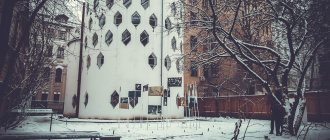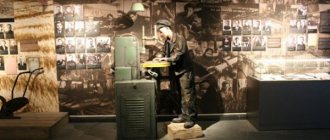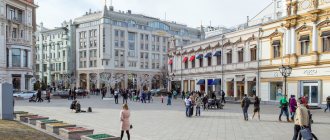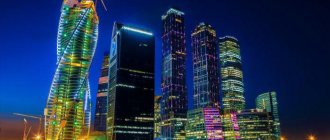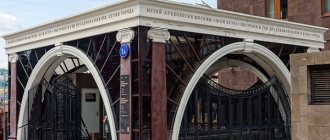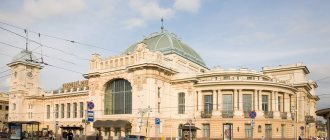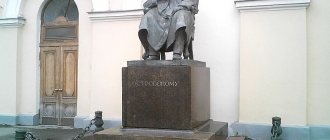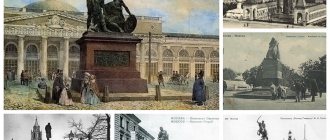“I have some kind of lattice on my plate...”
Alexander Aleksandrovich Porokhovshchikov, who was engaged in contract construction work, came from hereditary nobles of the Moscow province, served in the Semenovsky Life Guards Regiment, and retired with the rank of staff captain. His reputation in society was ambiguous: some admired Porokhovshchikov’s energy and ambition, others called him a projector and a talker. But he went down in history, as did the restaurant he built in 1872.
Conceived by Porokhovshchikov, the large shopping and hotel complex on Nikolskaya consisted of a hotel (68 rooms costing from 1.5 to 10 rubles per day), a concert and lecture hall and retail space. Initially, the hotel was connected to a semicircular commercial building that stood in the courtyard. And if it attracted more and more guests, then trade was sluggish. Therefore, in 1873, it was decided to convert the retail space into a restaurant. The author of the project was the architect A.E. Weber, who arrived from Vienna at the invitation of Porokhovshchikov.
The appearance of the restaurant made an indelible impression on visitors. Writer P.D. Boborykin described the interior decoration of the room as follows:
“The hall... amazed visitors from the provinces, and even Muscovites who rarely visited it, with its spaciousness, light from above, movement, and architectural details. Cast-iron painted pillars and a platform protruding in the middle, with cupids and curlicues, filled the emptiness of the huge colossus and caught the eye... An oval row of wide windows on the second floor, with busts of Russian writers in the piers, showed tiled wallpaper from inside the drapery, figured doors, skylights platforms, windows, stairs. A pool with a fountain added to the softened patter of feet on the asphalt the subtle murmur of streams of water... beckoned to tables covered with fresh, glossy ironed linen... a black buffet with decorations under the clock, occupying the entire back wall, covered entirely with snacks..."
The frequent interlacing of the glass ceiling became a distinctive feature of the establishment; it attracted attention and became a reason for funny stories. Gilyarovsky wrote down one of these: “Once two big swindlers were sitting at breakfast in the Slavic Bazaar. One says to the other: “You see, I have some kind of bars on my plate... What does this mean? This means that you will not escape prison! Omen!" “And the plate clearly reflected the frames of the glass ceiling windows.”
Breakfast before the cranes
Slavic Bazaar was the first Russian restaurant in Moscow. Before this, restaurants were opened exclusively by the French, and only taverns with large wooden tables and smoked ceilings were Russian. In the “Slavic Bazaar” the cuisine was also Russian, but the service was in the European style. Chef Vladimir Ivanov studied in Paris and received all kinds of professional awards.
The colorfully designed bilingual (Russian and French) menu of the “Slavic Bazaar” invited guests to enjoy the best dishes of Russian cuisine: sterlet, salted cartilage and saffron milk caps, botvinya, fish soup, suckling pig with horseradish and much more. Moreover, the most desired meal was breakfast from 12.00 to 15.00. At this time, merchants came to the restaurant to complete transactions worth millions. Some stayed even after three, having breakfast before the cranes. The guests asked for them after champagne and coffee with liqueurs: excellent, expensive cognac was poured into a crystal decanter painted with golden cranes. Such a decanter cost a fabulous 50 rubles - at the end of the 19th century this was equivalent to two monthly salaries of a primary school teacher or three average salaries of a factory worker!
Those who paid for cognac received an empty decanter as a souvenir. Many Moscow merchants collected “crane” decanters and boasted about their number.
The prices for vodka in the luxurious buffet of the Slavic Bazaar were also high. A glass cost 30 kopecks, while in most Moscow restaurants it cost no more than 10. But you could have a snack without restrictions!
Burnt Slavic Bazaar
Porokhovshchikov liked the projects of the 33-year-old master, trained at the Imperial Art Academy, in Vienna, which was then influencing the architecture of Europe, and he invited him to settle and work in Moscow. Weber did not return to his homeland, he lived there for the rest of his life, and for thirty years he built apartment buildings, mansions, hotels, and everything that was ordered for him in the eclectic style. The facades of two of his famous buildings have been preserved: Eliseevsky grocery store No. 1 and the Circus on Tsvetnoy Boulevard.
At Nikolskaya, 17, Porokhovshchikov surprised the city: he converted an ancient building into the luxurious Slavic Bazaar hotel with a concert and exhibition hall called the Russian Chamber. For the hotel, the Viennese architect commissioned the Slavic Bazaar restaurant, revered by wealthy merchants. “All the rich merchants of Moscow have breakfast there,” reported the guidebook “Around Moscow” for 1915. The service there was like in the best establishments in Europe, and only Russian cuisine was served on the table.
Here, as is known from the history of art, the writer and theater reviewer Nemirovich-Danchenko invited manufacturer Konstantin Alekseev, who performed on stage under the pseudonym Stanislavsky, to a business meeting. The legendary conversation lasted seventeen hours and ended with the opening of the Art Theater. Chekhov stayed at the “Slavic Bazaar”, the heroes of his captivating story “The Lady with the Dog” Anna Sergeevna and Doctor Gurov secretly met….
After the revolution, there was no hotel, no concert hall, no restaurant. It was recreated under Soviet rule in 1966. The Slavic Bazaar did not survive perestroika and burned down in 1993. A restaurant was opened under this name in Zamoskvorechye, but this is Fedot, but not the same one.
Managers in charge of real estate in Moscow are concerned with short-term profit and, to the detriment of the city, manage the fate of institutions with a century-old history, mentioned by classics, memoirists, associated with the destinies of generations of Muscovites. They are closed and have been abandoned for years, like the Aragvi restaurant. They are handed over to the cold hands of businessmen, for whom the concept of “monument” is an empty phrase; allow you to change the function, turning a hairdresser and a pharmacy of the 19th century into something ordinary, devoid of the aroma of the past.
There is no more “Slavic Bazaar” on Nikolskaya. There is no most beautiful pharmacy number 1, former Ferrein, on this street. There is no “Pushkin Shop” in Kamergersky Proezd, or second-hand bookstores and antique dealers on Arbat, where book lovers and collectors constantly went. The interest of visitors, Russians and foreigners, in attractions disappears, and the city loses more money than it gains as a result of the disappearance of glorious names, as they now say, brands.
The building on the corner of Tverskaya Street and Strastnoy Boulevard in 1917 belonged to hereditary honorary citizens Chizhov - merchant Andrei Gavrilovich, who was part of the trading house "A.G. Chizhov and V. Chizhov", and Evdokia Filippovna Chizhova - apparently relatives who lived in their own houses in Kalashnoy and Eropkinsky lanes, who lost everything they owned after the “socialist revolution”.
According to the information of local historian Yuri Fedosyuk in the book “Moscow in the Garden Ring”, in the 1920s “the publishing house “Working Moscow” was located in the corner building. There is no publishing house with this name in encyclopedias and reference books of the 20s. There is an editorial board of Rabochaya Moskva, which roamed to different addresses and changed its name more than once. This newspaper was published in 1918 as “Evening News of the Moscow Council of Workers and Red Army Deputies”; then it was called “Communist Labor”. The third name is “Working Moscow”. Fourth - “Moscow Bolshevik”. After the VKP[b], the All-Union Communist Party of the Bolsheviks, became the Communist Party of the Soviet Union, the CPSU, is published to this day as Moskovskaya Pravda. Here I served for over forty years, which I am very happy about, because I found the purpose of life, my theme, formulated in two words: “Moscow and Muscovites.”
It was impossible to earn much in it; from the contributions on the party card I see that it was rarely 300 rubles a month. But it was possible to write about aviation, fly throughout the Soviet Union and further, right up to Australia, where I visited. With a newspaper ID, one was allowed to climb the Spasskaya Tower, the Ivan the Great Bell Tower, and walk along the walls and towers of the Kremlin. He was the first to write about those who, after their death, ended up not in heaven, but on the pages of the volumes of the Moscow Encyclopedia edited by Academician S.O. Schmidt. In a city newspaper, without the restrictions practiced in central newspapers, I could often write, travel along the streets and alleys, which I do to this day, walking along the route of Strastnoy Boulevard...
When Tverskaya, having become Gorky Street, was built up with multi-storey buildings, two floors were built up to match them above the former property of the Chizhovs and the layout inside the building was changed. A cafe called “Pushkin” opened on the ground floor, which, as Yuri Fedosyuk writes, “caused sharp criticism from the public, and the cafe was renamed “Sport.” In 1934, the All-Russian Theater Society and the Actor's House with a concert hall were located on the upper floors of the building. The cafe turned into a closed restaurant, where no one except artists could get into from the street. They could take their friends with them, I once used this right with an escort, my actor friend. We found ourselves in a noisy, filled to capacity hall, where Stalin Prize winner, faded blond Sergei Gurzo, who became famous at the age of 23 after showing the film “The Young Guard” in all cinemas of the USSR, approached our table with an empty glass in his outstretched hand, in a begging pose. By that time, he had not been offered leading roles, and he drank out of grief. Nobody refused him vodka.
The hall under the roof was reached from the lobby by elevator. And there I found myself one day after the publication of an essay about Sergei Yesenin in November 1988, when there was no censorship. In it, he quoted, without distortion, lines from the poem “Homeless Rus',” inspired by a visit to a homeless colony. Looking into the faces of the boys warming themselves by the boilers with asphalt, spending the night in toilets, thinking about their future, Yesenin saw:
Pushkin is in them,
Lermontov,
Koltsov,
And our Nekrasov is in them.
I am in them.
This was followed by an ellipsis, which happens either when the author did not write something down, or the editors did not understand the words in the manuscript.
The stanza ended like this:
Is it not because of my sadness
The verse blows
Looking at them
Unwashed hari.
I found out what was hidden behind the ellipses in the special storage room of the Lenin Library, in its far corner, where I had access, possessing form number 2, which gave the right to visit closed enterprises and read secret documents. Censorship in the Collected Works of 1977 crossed out the words with which “unwashed hari” rhymed:
They even include Trotsky, Lenin and Bukharin.
Since 1927, when Trotsky was expelled from the USSR, it was possible to mention him for sixty years only with condemnation and curse. But Yesenin wrote about him without any condemnation. It turns out that before his fall from the heights of power, the chairman of the Revolutionary Military Council and a member of the Politburo, the People's Commissar for Military and Naval Affairs received in the Kremlin a poet who wanted to publish a magazine, Trotsky remembered Yesenin's poems, wrote about him, valued him highly, and put him on a par with the most outstanding poets. In the printing house of the armored train of the chairman of the Revolutionary Military Council, a collection of Yesenin’s poems “Starry Bull” was printed...
When the suicide happened, Trotsky wrote an essay “In Memory of Sergei Yesenin,” published simultaneously in Pravda and Izvestia. It was read in the Moscow Art Theater hall at an evening in memory of the deceased. It began on a mournful note: “We have lost Yesenin - such a wonderful poet, so fresh, so real. And so tragically lost, he left on his own, saying goodbye in blood..."
The reading ended just as eloquently: “The poet has died. Long live poetry! An unprotected human child fell into a cliff! Long live creative life, into which Sergei Yesenin wove precious threads of poetry until the last minute.” Many in the hall had tears in their eyes.
Today one can write about Trotsky without consequences, without calling him a “demon of the revolution” or an “enemy of the people.” And a quarter of a century ago, a publication in the newspaper of the Moscow City Committee of the CPSU and the Moscow City Council broke through the barrier. I received a call with congratulations from the luminary of Soviet journalism Leonid Likhodeev and professor Vladlen Sirotkin, who offered to perform at the “House of Actor”. I went there with apprehension; I remembered that when I ordered the book “Literature and Revolution” from the special depository, the girl librarian warned me: anyone who is interested in Trotsky is interested in the KGB.
In a crowded hall, where images of great actors looked down from the wall, I heard a surviving Trotskyist, a member of the All-Russian Central Executive Committee, who served half his life in prisons and camps. The speaker was the daughter of the fearless Ivar Smilga, a comrade-in-arms of Trotsky, who commanded the army and front during the Civil War and was shot in 1937. I heard Professor Sirotkin, the author of the book “Why Trotsky Lost to Stalin,” who lectured at the departments of the Sorbonne, Cambridge, Princeton and Berkeley. And unsuccessfully searching for the “royal gold.”
The “Actor’s House” soon burned down after that evening. The name of the trade and business building, which filled the floors where Moscow actors heartily relaxed and got drunk, reminds us of it.
They added three floors, which became level with the “House of Actor”, and the neighboring building under the same number 16/2. It appeared in 1863. He's been gone for a while now. Many people remember this large house, where the Moscow News editorial office was located on the second floor. Newspapers, like theaters, experience ups and downs and depend: some on the talent of the chief director, others on the will, energy and intelligence of the editor-in-chief. Few people in Moscow read the Novosti Press Agency newspaper, which wrote about the advantages of socialism over capitalism, until Yegor Yakovlev came to the editorial office. There was success where he was appointed editor-in-chief. This happened with the Journalist magazine. This has happened with Moscow News since 1986. People were waiting for the release of the latest issue at the Soyuzpechat kiosks; people were glued to the glass cases where pages of the newspaper were displayed.
In Moscow News I managed to publish an unknown letter from Mikhail Sholokhov, signed on June 18, 1929. Then the people went wild, robbed on the Don by harvesters who left bare walls in their houses. For such matters, the 24-year-old writer proposed to “take everyone to thick sieves, right up to Kalinin.” The Soviet government “ruined the Cossacks worse than the whites did in 1919.” The letter was rejected by Pravda, the text was typed in Izvestia and returned, paying in proofs. How did Moscow News manage to get around the obstacles?
Arriving in the narrow corridor of what was obviously a former hotel, I met familiar faces at MN and was especially happy to meet Most. With a gold medal, Alexander Mostovshchikov was not accepted into the journalism department, which boasted of “party affiliation,” because he received the medal in a camp where he was sent as a child under the nickname Sashka the King. He was lucky during the “thaw”. Khrushchev met with someone like him who had been released, as newspapers wrote about, calling for those who had broken the law to be taken on bail.
Alexander Mostovshchikov holds a “pyramid”. Above him are V. Drannikov, V. Vokhmyanin, A. Razin and V. Markov. Photo from 1968. Photo: Vladimir Torgaev
Therefore, when Mostovshchikov brought the note to the editor, he was not given a turn away, as at the faculty. He ended up in my information department. And quickly, despite his unexpunged conviction, he turned from a freelance correspondent into a full-time “literary employee” with a salary of 880 rubles a month. He learned everything easily, joking and playing. Feeling his breath behind my back for seven years, I myself became more confident. In addition to notes, Most composed something more significant, but he became not an outstanding novelist, like his and my friend Sasha Nezhny, but a successful journalist, executive secretary of Moscow News. He had such physical strength that he could hold four pranksters on his shoulders, as can be seen in the photo published in MK. It seemed that he would outlive us all, but the first one died. Many saw him off, not hiding their tears. Former editor-in-chief of Moscow News Yegor Yakovlev said goodbye to him. That day he revealed to me the secret of publishing Sholokhov’s letter. The first to read the heated words were the assistants to the General Secretary of the CPSU Central Committee and Mikhail Gorbachev himself, the father of glasnost. Many journalists, including me, owe the best publications to the newspaper.
Editor of Moscow News Egor Yakovlev.
The publication of the newspaper this year has resumed in an updated form and spirit. The editor-in-chief, who today signed Moscow News without news, did not publish. A long time ago I knew his father, a professor at the Faculty of Journalism at Moscow State University, Semyon Moiseevich Gurevich, to whom he brought notes to the Moscow University newspaper. He reminded me of Pavel Ilyich, the “quiet Jew” mentioned by Mayakovsky in the poem “Good.” The smile of a happy man, satisfied with life, never left his face. I didn’t know then, like all the students, that our teacher, an expert on Karl Marx, was happy because he survived the war. He, a military translator from the German language, was parachuted into the partisans of Belarus. He interrogated captured German soldiers. Semyon Moiseevich served as an assistant to the legendary chief of the Central Headquarters of the partisan movement, Panteleimon Kondratievich Ponomarenko, who amazed him with his amazing memory. And he has it well at 92 years old. He recently published a memoir, “Simply - About Life.” I take this opportunity to wish him health and long life.
Fountain - in a public toilet
Next to the restaurant were Trade Rows and Gostiny Dvor, where merchant families settled. In the 19th century, offices and banks appeared here. It is not surprising that the Slavic Bazaar turned into an important center of business life; merchants from all over Russia came here to conclude deals in the informal atmosphere of a separate office. This manner of doing business was considered good manners. Alas, immediately after the revolution the hotel was ruined. According to the memoirs of contemporaries, potbelly stoves began to be heated with mahogany furniture, and the fountain was turned into a public toilet. The outrages, however, stopped when the People's Commissariat of Justice was located in the former hotel. The Ministry of Energy also lived here, and in 1969, for some time, the Children's Musical Theater named after N.I. Sats.
As for the restaurant, it was for a long time turned into a closed food outlet for senior officials of the Central Committee and the Council of Ministers. The menu has changed little; they served the same dishes of Russian cuisine for which the former “Slavic Bazaar” was famous: Suvorov-style stew (sturgeon with potatoes, onions and fresh mushrooms), Old Moscow solyanka, fruit soup with biscuits...
The Slavic Bazaar became publicly accessible again only in 1966.
On December 21, 1993, a fire occurred in the restaurant building. Only the brick frame with facade decor has survived. Today the building belongs to the Musical Theater named after. Boris Pokrovsky, who works in a former hotel building. In April 2014, development began on a project to restore the restaurant building; the theater would like to open a second stage there.
Russian table at Testov Restaurant
Restaurant Testova (right). Late 1880s. Moscow. Photo: pastvu.com
The building where Testov's restaurant was located before the revolution. 1957. Moscow. Photo: pastvu.com
On Teatralnaya Square, where the Moscow Hotel and the monument to Karl Marx are now located, in the 19th century there was a luxurious house of millionaire merchants Ilya and Pavel Patrikeev. In 1868, the former clerk Ivan Testov persuaded them to rent out the first floor of the building. A sign “Big Patrikeevsky Tavern” appeared above the entrance, and a little lower - the inscription “I.Ya. Tests."
Testov sold the deal, flaunting the Russian table. Both merchants and gentry flocked to the new tavern. Trade was especially brisk from August, when landowners from all over Russia took their children to study in educational institutions in Moscow and when a tradition was established - to dine with children at Testov’s or at Dubrovin’s “Saratov”... The St. Petersburg nobility, led by the Grand Dukes, specially came from St. Petersburg to eat test pig, crayfish soup with pies and the famous Guryev porridge.
Vladimir Gilyarovsky, “Moscow and Muscovites”
Fyodor Dostoevsky visited Testov when he came to Moscow. Fyodor Chaliapin came to the restaurant for pie and often brought his friend Sergei Rachmaninov with him to treat him with his signature suckling pigs on fire. Anton Chekhov met with his publishers here.
In the early 1900s, the “Big Patrikeevsky Tavern” began to be called “Testov’s Restaurant”, according to the fashion of those years.
From the Testov tavern only antique furniture remained in two or three rooms, and everything else is unrecognizable! Even the walls are different. Old Muscovites-gourmets stopped going to Testov. Visiting merchants, who had not been to Moscow for several years, did not recognize the tavern. First of all, a decadent picture on the mirror window of the lobby... In the large hall there is modernist furniture, which a ten-pound merchant would be afraid to sit on.
Vladimir Gilyarovsky, “Moscow and Muscovites”
During the revolution, the establishment closed. In 1921, the “Ancient Restaurant I.I.” reappeared in Moscow. Testov”, who worked for only eight years. And at the end of the 1960s, the building in which it was located was demolished.
MENU “GILYAROVSKY’S DREAM”
Prepare just three dishes and you will feel the unique aroma of the “Slavic Bazaar”
Salted saffron milk caps
Skoblyanka- fried fruit soup with biscuit
Salted saffron milk caps
Ingredients:
For 1 kg of fresh saffron milk caps you will need: table salt - two tbsp. l. without top; garlic - 3 cloves; dill - several sprigs; cloves - 4 inflorescences; horseradish - 1 leaf; oak, currant leaves, spruce and heather branches.
Recipe:
Dry the washed, peeled mushrooms on a towel, cut off the caps from the stems, leaving no more than 0.5 cm. Prepare an enamel pan. Pour a little salt into the bottom of the pan, cover with half a horseradish leaf, oak and currant leaves, and a spruce sprig. Sequentially lay out layers of saffron milk caps, sprinkling each with salt and spices. Lay the middle, as well as the topmost salted layer with leaves and pine needles, cover everything with the remaining half of the horseradish leaf. Place a plate or wooden circle of a suitable size on top, wrapped in clean gauze, and load with pressure. Leave the workpiece in a cool place at a temperature not lower than 0 C and not higher than 6 C for 2-3 weeks. During this time, the mushrooms will settle, release their juice, be salted and soaked in spices. Then they can be placed in prepared jars, closed with boiled lids (you should not use roll-on lids for this type of preparation) and stored.
Skoblyanka-frying
Ingredients:
any meat - 200 g, mushrooms 100-150 g, potatoes - 3-4 large pieces, onions - 1 piece, sour cream - 2-3 tbsp. l., mustard - 1 tsp., salt, ground black pepper - to taste, dill - several sprigs, red currants, lingonberries, cranberries - for decoration.
Recipe:
meat, mushrooms and potatoes are cooked in a separate frying pan. To make the process go faster, use three pans at once. Place the chopped pieces of meat in a bowl, add salt and pepper and let marinate for 30-40 minutes. If you use wild mushrooms, you must first boil them; if you use champignons, you can immediately cut them and fry them in vegetable oil. Before the mushrooms, put the onion in the frying pan and fry it until transparent, then add the mushrooms. Fry everything until a golden brown crust appears, and then add sour cream and mustard. When the sauce with mushrooms thickens, transfer the contents to another container, wash the frying pan and fry the cut potatoes in it. Fry the marinated meat in a separate pan as well. Thin slices will fry quickly. Add meat and mushrooms to the finished potatoes. Mix everything carefully, cover with a lid and keep on low heat for no more than five minutes.

